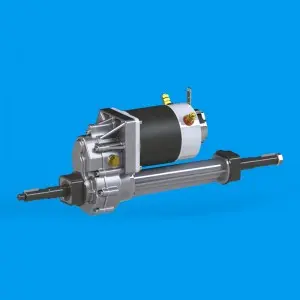When it comes to automotive engineering, transaxle gearboxes play a vital role in ensuring optimal performance and smooth driving of your vehicle. This mechanical marvel combines the functions of a transmission and a differential to not only transmit power from the engine to the wheels, but also provide torque distribution and gear shifting. In this blog, we’ll delve into the complex workings of a transaxle gearbox and reveal its importance in modern cars.
1. What is a transaxle gearbox?
A transaxle gearbox is a special type of powertrain component that combines the functions of the driveline and final drive unit. It is commonly found in front-wheel drive and mid-engine vehicles, where the engine and transmission are integrated into a single unit. This integration allows for better weight distribution and interior space utilization, making it ideal for compact cars and high-performance vehicles.
2. Transaxle gearbox components
The transaxle transmission consists of several key components that work in harmony to transfer power from the engine to the wheels:
A. Bell Housing: The bell housing serves as the connection point between the engine and transmission. It houses the clutch or torque converter assembly, depending on the vehicle type.
b. Input shaft: The input shaft receives the rotation from the engine and transmits it to the transmission.
C. Gear Set: The gear set, also known as the gear train, is responsible for changing the speed and torque of the output shaft. They consist of multiple gears of different sizes that mesh and disengage based on driver input.
d. Differential: The differential is located at the end of the gearbox and distributes torque to the wheels while allowing them to rotate at different speeds when cornering.
e. Output shaft: The output shaft is connected to the differential and transmits power to the wheels.
3. How does the transaxle gearbox work?
The working principle of a transaxle gearbox involves multiple steps to ensure seamless transfer of power and torque:
A. Selection of gears: The driver selects the desired gear ratio according to driving conditions and shifts gears accordingly.
b. Input shaft rotation: When the driver releases the clutch or engages the torque converter, the input shaft begins to rotate with the power of the engine.
C. Gear meshing: A set of gears within a transmission that mesh and disengage based on gear selection.
d. Torque distribution: The differential receives power from the output shaft and distributes torque evenly to the wheels. In front-wheel drive vehicles, it also counteracts the phenomenon of torque steer.
4. The significance of transaxle gearbox
Compared with traditional transmission systems, transaxle gearboxes have several advantages:
A. Weight Distribution: By combining the transmission and differential, a transaxle transmission better distributes weight within the vehicle, improving handling and stability.
b. Space optimization: The compact design of the transaxle gearbox not only saves space, but also simplifies the manufacturing process, making it cost-effective.
C. Improved efficiency: Integration of the transmission and differential reduces power losses and increases overall efficiency, resulting in improved fuel economy and reduced emissions.
Transaxle gearboxes are an important part of a car’s complex machinery, enabling efficient power transmission, gear shifting and torque distribution. Its integration into the drivetrain has revolutionized the automotive industry, helping to increase performance, improve handling and increase fuel efficiency. Understanding how a transaxle transmission works allows us to appreciate the engineering wonder behind the smooth operation of our beloved vehicles.
Post time: Nov-10-2023


